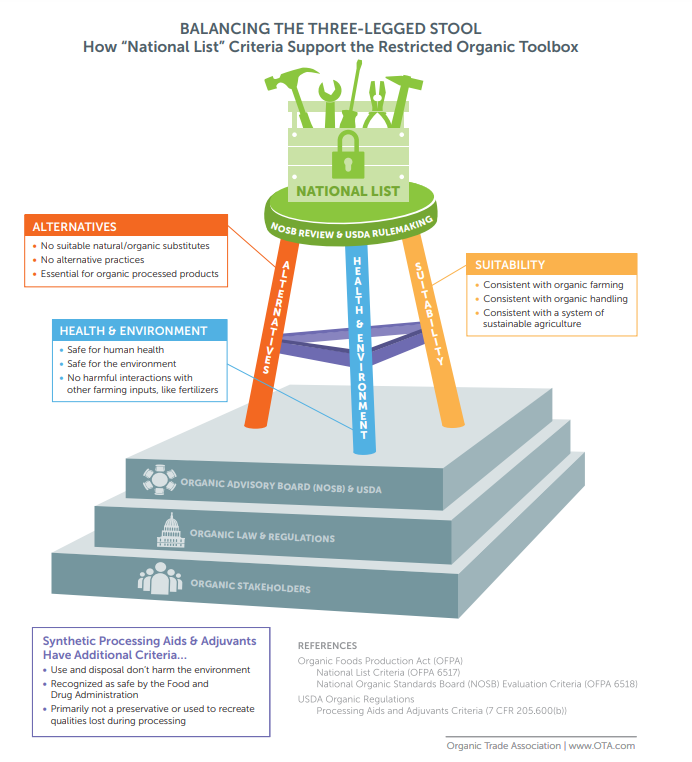The National Organic Standards Board (NOSB) is a Federal Advisory Committee charged with the task of advising the USDA Secretary of Agriculture on which substances should be allowed or prohibited in organic farming and processing. The Board also advises the Secretary on other aspects of the organic regulations.
NOSB Fall 2024 Meeting Details
The Organic Trade Association submits comments to the NOSB on behalf of its membership. Our positions and policies are primarily shaped through our member task forces. In all cases, OTA’s regulatory staff carry out an extensive process of membership engagement to capture how NOSB proposals will impact certified organic farmers and handlers. Prior to submission of final comments, draft comments are distributed to membership at least a week in advance. Members are provided an opportunity to weigh in and shape any changes that may be needed prior to final submission.
Blue
NOSB Background
The passage of the Organic Foods Production Act, a sub-section of the 1990 Farm Bill, provided the foundation for uniform national organic standards for the production and handling of foods labeled as “organic.” The Act authorized a new USDA National Organic Program (NOP) to set national standards for the production, handling, and processing of organically grown agricultural products and to oversee the certification of organic operations. The Act also established the National Organic Standards Board (NOSB) to ensure an open, balanced and transparent process for setting and revising organic standards. NOSB plays a critical role in the organic rulemaking process because it advises USDA on which production inputs should be allowed or prohibited in organic farming and processing. NOSB also makes recommendations on a wide variety of other standards issues, such as organic pet food standards, aquaculture standards, animal welfare standards, and organic inspector qualifications.

Blue
NOSB Members
The composition of NOSB, as detailed in the Organic Foods Production Act, was carefully designed to ensure balanced stakeholder input into the rulemaking process. This 15-member volunteer citizen advisory board is designed to represent the diversity of the organic community across the United States to help ensure that all perspectives are considered before final recommendations are presented to the Secretary of Agriculture. The number and ratio of seats were allocated intentionally so that sectors must achieve consensus to pass a recommendation, ensuring balance of interest, with none predominating. And, in order for any motion to carry, a two-thirds vote is required to prevent any one interest from controlling the Board. It is this construct that helped give the organic label the credibility that it has today as well as the platform for its exponential growth.
NOSB consists of four farmers, two handlers/processors, one retailer, one scientist, three consumer/public-interest advocates, three environmentalists, and a certifying agent.
You can find the current NOSB Members here.
Each NOSB member is appointed by the U.S. Secretary of Agriculture for a five-year term. OTA members interested in serving on NOSB may contact Scott Rice for guidance on the nomination process.
Blue
NOSB Meetings
NOSB meets twice a year in a public forum to discuss and vote on subcommittee proposals related to the National List or other organic standards issues. The meetings also allow NOSB to receive updates from USDA’s National Organic Program (NOP) on issues pertaining to organic agriculture. NOSB meetings are an opportunity for stakeholders to give feedback on proposed NOSB recommendations and discussion items. NOSB first publishes proposals with a request for public comments. Prior to the meeting, NOSB members review literally thousands of pages of comments. During NOSB meetings, the full Board listens to oral public comments, discusses the proposals, and then votes on whether to pass the subcommittee proposals. NOSB subsequently submits its final recommendations to USDA.
Our Resources from Past NOSB Meetings:
Past NOSB Meetings
Blue
NOSB Recommendations
If an NOSB proposal receives a decisive vote (2/3 majority) by Board members in favor of the proposed motion, it becomes a recommendation to the USDA, and is provided to the Secretary through the AMS National Organic Program.
Past NOSB Recommendations
Blue
The National List
A primary function and responsibility of the NOSB is to determine the suitability of the inputs that may be used in organic farming and handling and making recommendations for including or removing inputs from the National List of Allowed and Prohibited Substances. The organic law (OFPA) and the organic regulations include a number of factors NOSB must consider when recommending inputs for inclusion on the National List. If one takes a look at the sum of all parts, the conditions that must be met fall into three main clearly stipulated criteria: 1) the input is necessary or essential because of the unavailability of natural or organic alternatives; 2) the input is not harmful to human health or the environment; and 3) the input is suitable with organic farming and handling.
Visit our National List webpage for more details

Blue
Sunset Review
Once a material has been added to the National List, NOSB must re-review the material every five years to confirm that the material continues to meet the National List criteria. This re-review process is known as the “Sunset Review” process. Through this process, NOSB can remove inputs from the National List based on any new information regarding adverse impact on human health or the environment, or the availability of a natural or organic alternative. After NOSB completes its Sunset Review and provides a recommendation, USDA either renews or removes the input to complete the Sunset Review process. The Sunset Review process must be completed prior to the material’s Sunset Date, which is the five years from its initial listing or most recent renewal on the National List. Therefore, NOSB reviews these materials well in advance to ensure there is time to complete the entire Sunset Review process prior to the material’s Sunset Date.
